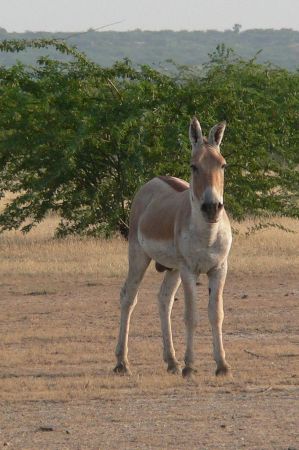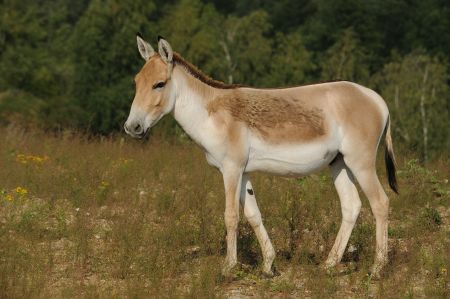Kunga donkey hybrid already bred 4,500 years ago
- Written by Portal Editor
Long before domesticated horses were introduced to Mesopotamia around 4,000 years ago, the people living there were breeding hoofed animals that they harnessed to war chariots and plows and used for diplomatic and ceremonial purposes: so-called kungas.
However, the genetic origin of these donkey-like animals was previously unclear. DNA analyzes of kunga skeletons from Syria now show that the kungas were a cross between female domestic donkeys and male wild donkeys. They are thus the oldest hybrids bred by humans.
Throughout history, horses and other equidae have played a key role in the development of cultures, but also in warfare. A 4,500-year-old Sumerian mosaic shows that the Sumerians were already using chariots on the battlefield that were pulled by horse-like animals. However, domestic horses were not introduced to this region until around 500 years later. Cuneiform clay tablets from the period mention so-called kunga, prestigious hoofed animals that cost around six times more than the domestic donkeys commonly used at the time. Exactly what the kungas were was a matter of debate for a long time.
Ancient DNA from donkeys, horses and relatives
 A team led by Andrew Bennett from the University of Paris has now solved this mystery. To do this, the researchers examined the ancient DNA from 25 equine skeletons found in the 4,500-year-old stately tomb of Tell Umm el-Marra in northern Syria / Mesopotamia. Mesopotamia was a historical area in the Middle East that includes most of modern-day Iraq but had once extended to parts of Syria and Turkey. Domestic horses in the region date back to 4,000 years ago, according to the same research group.
A team led by Andrew Bennett from the University of Paris has now solved this mystery. To do this, the researchers examined the ancient DNA from 25 equine skeletons found in the 4,500-year-old stately tomb of Tell Umm el-Marra in northern Syria / Mesopotamia. Mesopotamia was a historical area in the Middle East that includes most of modern-day Iraq but had once extended to parts of Syria and Turkey. Domestic horses in the region date back to 4,000 years ago, according to the same research group.
While the shape of the skeletons was equine, it was not in keeping with horses, donkeys, or the onagers wild in the region. Paleontologists had previously assumed that it could be the enigmatic Kunga.
"In order to clarify whether the tombs of Tell Umm el-Marra actually contained the remains of the politically and symbolically important kunga and to determine the taxonomic status of these animals, we examined the genomes in samples of these skeletons and compared them with other equine samples," explain the researchers. They used the genomes of domesticated donkeys and horses as a comparison, and they also sequenced the genomes of extinct wild donkeys that were native to the region at the time. To identify the mother and father of the animals studied, Bennett and his colleagues focused on the mitochondrial DNA, which is passed exclusively from the mother, and the Y chromosome, which comes from the father.
Combined advantages of both parents
 The result: The kunga were crosses between female domestic donkeys and male Syrian wild asses that became extinct in the early 20th century. "We have thus documented the oldest evidence for the breeding of hybrid animals," the researchers write. The oldest proven human-bred hybrid to date was a mule bred in Anatolia from about 1000 to 800 BC. Like mules and hinnies, which are the result of crossing horses and donkeys, the kunga were probably non-reproductive. In order to breed kunga, male wild donkeys had to be captured and mated with female donkeys.
The result: The kunga were crosses between female domestic donkeys and male Syrian wild asses that became extinct in the early 20th century. "We have thus documented the oldest evidence for the breeding of hybrid animals," the researchers write. The oldest proven human-bred hybrid to date was a mule bred in Anatolia from about 1000 to 800 BC. Like mules and hinnies, which are the result of crossing horses and donkeys, the kunga were probably non-reproductive. In order to breed kunga, male wild donkeys had to be captured and mated with female donkeys.
The bones preserved in the tomb indicate that the kunga were stronger and faster than donkeys. The Sumerians apparently used the advantages of both parent animals through hybrid breeding: the power and speed of the wild donkey, combined with the better controllability of the domestic donkey. However, they did not tame the wild horses living in the region. About 4,000 years ago, however, domestic horses were introduced to the region from the Pontic steppe. Since they were easier to reproduce and offered similarly good characteristics, they subsequently supplanted the kunga. In future studies, the researchers plan to examine other equids from similar spatial and temporal contexts in order to better understand the extent of Sumerian hybrid breeding.
Please read as well:
